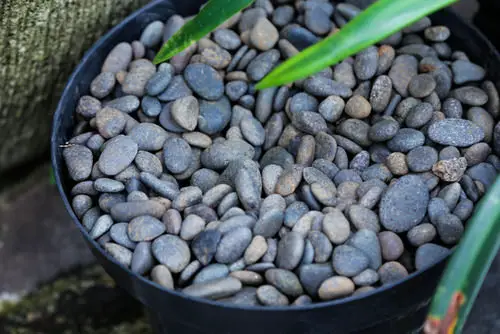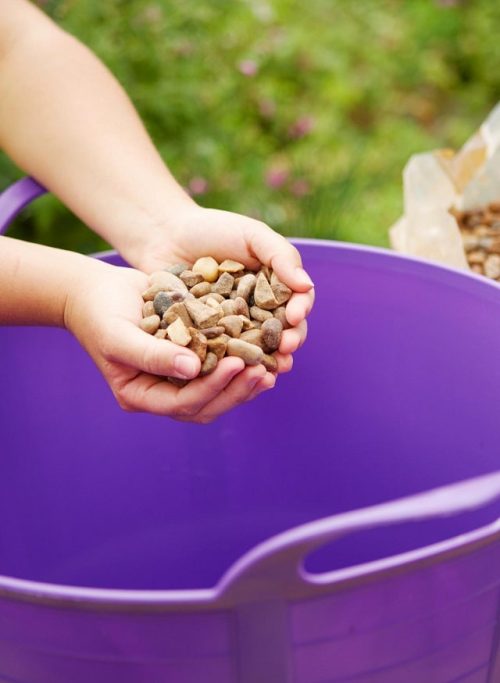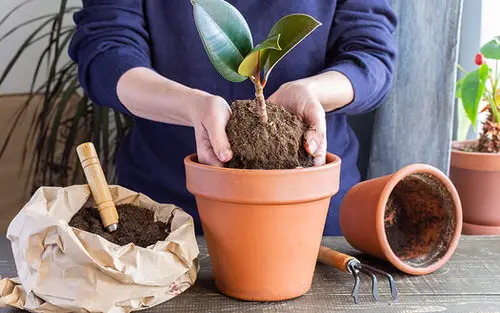Wondering Why You Should Not Add Gravels to Pots? Here’s us busting an old myth of the most common practice gardeners follow.

Every time you prepare a pot for planting, you add a layer of gravel in the bottom for drainage! But is it essential or not required at all? Why You Should Not Add Gravels to Pots? Or should you? Let’s find out!
Find out some surprising benefits of using human hair in the garden here
Should You Add Gravels to Pots?
Adding a layer of gravel, stones, or pot shards to the bottom of the container is a common practice that most gardeners (old or new or even experts) do. But do you really need to do this? We say NO!
To support our claim, we refer to this educative article on Illinois University, which states –
It is a myth that a layer of gravel (inside the bottom of an individual pot) beneath the soil improves container drainage. Instead of extra water draining immediately into the gravel, the water ‘perches’ or gathers in the soil just above the gravel.
The water gathers until no air space is left. Once all the available soil air space fills up, the excess water drains into the gravel below. So gravel in the bottom does little to keep soil above it from being saturated by overwatering.
Does Gravel Help With Drainage?

If you are confused if gravel help with drainage, then the answer is No. Soil scientist Kevin Handreck, the author of Gardening DownUnder and Good Gardens with Less Water, states that crocking increases the risk of damaging your plants by overwatering. In fact, adding a layer of gravel at the bottom of the pot will impair it.
Associate Professor Linda Chalker-Scott, an urban horticulturist at Washington State University, calls it a myth that refuses to die. She says regardless of solid scientific evidence to the contrary in her report! Nearly every book or website on container gardening recommends placing coarse material at the bottom of containers for drainage.
Does a Layer of Gravel Improve Air Circulation?
We know that plants need good drainage so that their roots can receive adequate oxygen, and we also know that water passes through a coarsely textured material faster than it does in fine material.
What we miss here is that water does not move easily from layers of finer textured materials to layers of more coarse-textured materials, which means instead of passing freely and easily, the water sits between the soil and drainage layer and doesn’t start to drop until the soil is saturated completely. ABC SCIENCE also tried to debunk this myth in its article; click here!
Julie Day posted a similar article on Today’s Homeowner in which she equated soil with a sponge. Read the complete article here!
Why You Should Not Add Gravels to Pots?

1. It Worsens the Drainage
In our practice, we didn’t find any help from adding a bottom layer of coarse material in containers. BBC too states that this is not true, and it’s better to have a layer of sand underneath soil that will allow water to drain into it and later be sucked up by roots if needed.
2. It Takes Additional Space
Adding gravel for drainage reduces the volume of soil available to plant roots. Basically, it means you make a pot even smaller in size and, as a result, get an unhappy crowded plant.
The article by James D. Kramer also supports the claim. You can check out his interesting article here!
3. It Causes Root Rot
University of California’s Master Gardener, Sue McDavid states that plants like good drainage, especially those in containers. If water pools around plant roots for long, root rot will damage and possibly kill the plant.
Instead of water draining immediately through the soil, then into gravel or other material, and out of the drainage holes, water will completely saturate the soil so that no air spaces are left. This could take a long time, and in the interim, plant roots will be starved for oxygen.
4. Gravel Adds Unnecessary Weight
A layer of gravel or pot shards at the bottom of a container adds unnecessary weight because it is heavier than most lightweight potting soils and becomes hard to move.
So, What Should You Do?

Actually, nothing. Keep the pot as it is. If you fear the soil getting washed out, you can prevent this by placing a layer of paper towel or newspaper over the holes before adding the growing medium.
Also, ensure that you never grow plants in a pot without drainage holes.
Learn some bizarre tricks to grow houseplants here
The Bottom Line
Adding gravel at the bottom of the container can severely hamper the drainage, which can waterlog the roots and prevent proper airflow. This will result in the growing medium attracting soil-borne diseases and root rot that may cause the death of a plant.



Totally agree……I always use an Onion bag mesh cut to the size of the bottom of pot……to stop mix from washing out ofthe pot…..i use quite big drainage holes for my citrus trees in pots and use onion mesh with every pot…..its very effective at preventing mix from draining away.
Good suggestion I’m going to try your idea, thank you.
I put coffee filters in the bottom of my pots to let the water pass but not the soil. Always put holes in the bottom of pots and set them off the hard surfaces so they can drain.
I live in the central part of South Dakota. The wind blows!!! I use a piece or 2 of brick to keep the pot from heading for the next county!
I agree with this article, however, I do put a layer of gravel in the bottom of my pots in order to weight them so the high winds in our area don’t knock them over. I lost a lot of nice ceramic and terra cotta pots in the past due to the winds lifting them and tossing them around the yard! The rock weight really helped prevent that. It’s good to know how it impacts the soil and root systems, though. I’ll have to be careful to watch the plants more closely and avoid overwatering. Thanks for sharing!
next time try using a brick or two, that’ll give the pot some weight without completely keeping the soil from reaching the bottom of the pot
Good to know.
I don’t agree I ‘ve used white marble rocks which I buy at Ace hardware . I always rinse it before I place them in the pots. Never had a problem . I also used the rocks in the pots for my indoor house plants. All my plants grow beautifully!!!
Think how more beautiful they’d have been if you hadn’t added the inhibiting rocks :-)
With the marble rocks the water is not retained it slides off, so i guess that’s just fine, but this article refers to gravel which retains water thus may clog up and does not give good drainage. i will stick to my potting mix or leaves for the bottom layer, it works fine for me.
What about using a layer of perlite at the bottom of the pot? Probably the same effect as gravel? Wish I’d known this sooner. I think my snake plant is suffering from not enough nutrient-rich soil and not enough room for its roots…
Succulent web sites recommend covering the pot hole with a piece of screen, like the mesh made for patching wall board. It sticks in place and then gets covered with lava rock and/or activated carbon. This is supposed to allow the drainage that succulents need. I have started to sue lava rock with other plants too but it is too soon to know the effect because I repotted some annuals that I brought in before frost. Years ago, I read about putting a layer of window screen in the bottom of the pot to keep the soil from washing out the drainage holes and that seems to work too.
Please correct the word that was supposed to be use in line 4 but was typed incorrectly as sue. Should have proofread my comment before I sent it.
The writer and a ‘number’ of Plant and soil scientists say something so we should all just forget about this old wives tale, right? Wrong.
It is reductive, and anti science to dismiss something so very complicated. Actually what is important is the type of plant, vs the growing medium, vs watering regime, vs A MILLION and one other variables that would take a thousand years to go over in a short reply.
So, why adding rocks or other hard medium might actually be a good thing?
1. Drainage holes, one can increase the air space under/between the plant and holes, creating a cave like cavity which can provide more oxygen near the root zone, reducing root rot, and allowing an automatic phenomena known as air root pruning. Also the roots are going to wrap around these uneven shapes and prevent root circling and binding in containers.
2. Rocks contain micro nutrients, which erode over time, Roots latch onto these rocks and can slowly suck these rocks, if the plant lives for many years in one container this could be of use for extra minerals
3. If the plants medium contains mycorrhiza, the friendly fungus that gives the plants roots essentially another root system. These strands will explore the whole growing medium, these are much faster at eroding and eating from harder rocks, they then feed minerals directly to their host, hopefully the plant.
4. Pot stabilization, outdoor plants when dry can fall over. The extra weight, provides a bottom heavy counter balance.
5. Rocks, rockdust, oyster shells, and whatever other solid material can adjust ph, up or down over many years. Slowly buffering the medium that sits in direct contact with it. Its not impossible a plant in a container will make use of this.
Yes one can see why sometimes adding things in stratified layers to plant vessels isn’t always necessary, but to definitively say it is pointless for any of the 500,000 known species is utterly ignorant.
True scientist wouldn’t/shouldn’t make grand statements, and honestly science is all about disagreement, and questing everything. This is not a criticism of the article but a small attempt at dismissing the *UNBUSTABLE*.
Happy gardening, and never stop experimenting.
Great Gorrila! This is such an interesting and informed comment. Your clearly a fountain of knowledge, so much so ive taken notes for a lecture about biosynthesis of soil fungus and rock minerals. I hope you dont mind.
Thanks Lula.
It’s many years later, and behold…. i find your friendly comment.
Hope the lecture went well, a very interesting subject indeed.
I think, you really might find, *Terra-preta*, of great interest, given the topic of you lecture, if perhaps you have not researched this amazing material already.
Gorilla Finger…anybody!?!? Please tell me your opinion regarding the use of polymer-coated gravel (as is often used in aquariums) as a substitute for perlite or sharp sand for growing indoor succulents??? Still have time to get a refund if necessary, so thanks for any advice!
I do wish id seen this earlier.
Yes they will grow if this is added to soil, assuming it is aquarium safe. But i would avoid the stuff, it leaches/oozes weird breaking down polymers after a while. Also once mixed with a soil/other medium, one cannot easily dispose of it. Certainly wouldn’t corrupt a compost bin with it! As a side note i have some blue coated gravel that has stayed blue for 10+ years, so its not the end of the world. Id still get a refund or just top dress with it for the visual effect (if its colored), then scoop it off and chuck it after a few years.
Check out Akadama (used in bonsai soil), the fine/small particulate, looks really pretty as a top dress for succulents. Lasts for years and naturally breaks down.
Have fun gardening.
lol I do wish I’d seen THIS earlier…took a salesperson’s advice about the polymer issue, but ultimately chucked it all. Went ahead with ‘regular’ rocks and my succulent babies are still thriving. And no worries about not getting that refund…getting such valuable unbiased information from you is what matters…thanks!!!
Ayanna, its been an extra long time…… hehe. You are more than welcome. I do hope the succulents are thriving and now multiplying. Horticulture is so rewarding, one can never get bored, the pleasure to find out new things and experiment/think is what its all about!
Totally bad advice:
I have concrete planters around my house. I always usedold broken terracotta. My wife believes as you. All our plants drowned. We made a great breeding place for mosquitos. Soil impacted around the holes.
Look at the bottom of THE INSIDE of hanging pots. Those strainer thingies are awsome.
False: a drainage layer in the bottom of pots reduces the volume of soil available to plant roots. Don’t add gravel or crocks, but ensure pots have drainage holes.
False: a drainage layer in the bottom of pots reduces the volume of soil available to plant roots. Don’t add gravel or crocks, but ensure pots have drainage holes.